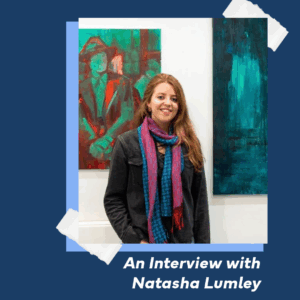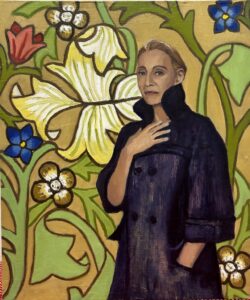This week, Signature reached out to Natasha Lumley, a profoundly deaf artist based in London whose artwork explores identity and the beauty of human expression. For Natasha, art is more than just a visual concept, rather it is a tool to communicate her experiences and connect across boundaries of sound and silence. From early influences such as the Mexican painter Frida Kahlo to discovering Deaf culture more fully, Natasha’s story is a reminder that art can be a language of its own. In this blog, Natasha reflects on her journey and offers heartfelt advice for those who are looking to pursue their creative path.
- Hi Natasha, first, can you introduce yourself to Signature engagers and tell us a little bit about yourself.
Hi, I’m Natasha and I am a profoundly deaf artist based in London. I work on all sorts of subjects from landscapes to semi-abstracts, mainly using oil paints, but portraiture is my forte. I completed two years of training in portraiture in London, where I focused on oils and worked directly from life (no photos of the models were allowed which can be challenging!) I’ve exhibited at the Wimbledon Art Fair the past two years and also take on private commissions.
- How did you first become interested in art, and was there any one or any piece which sparked this interest?
My mother came from a very artistic family so creativity was always around me. As a child, I would spend a lot of time drawing and painting. But I think the real spark came during my GCSEs, when I discovered the Mexican painter, Frida Kahlo, and learned about her life. I felt deeply moved by the suffering she endured and how she overcome the effects of a terrible accent through her art. You can really feel how she channelled her pain into her work- it’s bold, provoking and deeply personal. Her paintings are filled with hidden clues that seem to challenge the viewer and look deeper. In a way, my experience of being deaf also forces me to rely on visual clues to make sense of the world around me. It takes courage to be vulnerable and it is inspiring to see that bravery in Frida’s work, and I hope to be as daring as she was.
But it wasn’t until much later, during lockdown, around the time I graduated from university that I rediscovered my passion for creating art and realised I wanted to pursue art seriously.
- How was your experience growing up deaf and how do you think It has shaped who you are today?
I was born into a large hearing family, but I am lucky to have a deaf twin sister and we have always had each other and so we share that real understanding of what it’s like to be deaf. I had a great childhood first in South America where my father worked. It was there, in Chile, that my parents discovered I was deaf at the age of 2 ½ and where I had my first cochlear implant at 3 ½. Then we moved to England where I attended a deaf specialist boarding school. That’s where I found a strong sense of belonging and made lifelong deaf friends. Although I mainly used speech at home with hearing family (apart from my twin sister), I naturally picked up sign language from my deaf peers.
Things changed when I went to a mainstream sixth form. It was tough being surrounded by hearing peers with very little deaf awareness. In noisy group settings, I often masked how much I was struggling. I had to use speech constantly. People often assume that because I wear cochlear implants, I can hear everything, but that is it not true. I still miss a lot, and that can be tiring, frustrating, and isolating, especially when people forget I’m deaf. Though I had a lot of support in education which helped prepare me for university I still had to work harder on grammar. I graduated with a BA in History of Art and Visual Culture.
It wasn’t until after lockdown, when I moved to London, that I discovered the vibrant Deaf community and culture which has helped me embrace my deaf identity more fully.
I am grateful to be a part of both the hearing and Deaf worlds. The challenges I faced growing up were what built my resilience and strengths and shaped who I am. They taught me a lot about being brave and the need to confront the communication barriers and navigate frustration, preparing me for the wider world.
Finding my voice has taken time, but art has become my way to express myself without limitations. My deafness has made me more understanding, resilient, and accepting of imperfection. My English and speech may never be perfect and that’s okay. Art allows me to be myself and communication on my own terms.
- Did you have any role models in the deaf community or in the art world growing up, and if so, why?
I remember hearing about Rubbena Aurangzeb-Tariq who is a Deaf artist, BSL tour guide and also a qualified art psychotherapist. But it was not until last year that I met her when she came to my art degree show in London, and we had an enlightening discussion about the meaning of colour and her journey from studying art to become an art therapist. She encouraged me to go to a Deaf art retreat, which was a great experience.
It’s rare to have a deaf professional artist as a role model and who is also very supportive. I’m grateful to have met her. It is inspiring to see how much she has done for the deaf community; BSL art tours, workshops, life drawing classes, and art projects linked to mental health and Deaf identity and culture. She showed me what is possible.
- Has your deaf identity influenced your creative process or the way you express yourself through art?
Faces are the first thing I focus on because I lip-read, so I have spent my life studying faces to understand what’s happening around me. Facial expressions and body language are so important to how deaf people communicate and gather information through visual clues. Perhaps that’s why I was drawn to portraiture. So yes my deaf identity did influence my creative process. Studying portraiture then gave me a solid foundation in drawing. I then found I needed to really challenge myself to look deeper within myself.
Thanks to a scholarship I was awarded from the Painters and Stainers’ Guild, I was able to pursue a Post-Diploma in Figurative Art. That opportunity changed everything. It gave me the freedom to experiment and trust my intuition to express myself openly, whether through abstract or figurative work and opening new creative pathways. Ultimately, it challenged me to find my voice. I had to confront vulnerability and express the parts of myself I had kept hidden, particularly my deaf identity. At first, I hesitated to share this part of myself with hearing peers, but through my work, it became a central theme. Much of my work from my post diploma explores thresholds: the spaces between deaf and hearing, silence and sound, isolation, and connection.
- What key pieces of advice would you give to young deaf people who are interested in pursuing a creative career?
Remember “To live a creative life, we must lose our fear of being wrong” (Joseph Chilton Pearce)
Just let go of fear and striving for perfectionism and make space for experimentation and discovery. Mistakes are not failures, they’re simply part of the process. That’s how we grow and find our voice. I have come to realise that perfection isn’t the goal, but authenticity is.
Don’t wait for the “right” moment or inspiration. Just do it. You don’t have to have all the answers at the beginning.
- If you could give your younger self some key advice or words of inspiration, what would they be?
It would be this: Have trust in yourself and be brave. It’s so important to build a strong sense of self-belief even when it feels hard.
I remember reading something in a book that really stayed with me: “It’s not your job to judge your work- leave that to others. Your job is just to create”. That shifted my mindset. It reminded me to stop overthinking or criticising my work too soon and to just focus on making.
And finally. “Leap and the net will appear.” Trust that.
- Do you have any upcoming projects that you are working on which you can share with us?
Some of my paintings have been selected for the Edinburgh Deaf Festival, and I’ll also be giving a talk there on the 11th of August, which I am really excited about!
I will be starting an MA in Fine Art in London this September, and I am excited to take the next step in my journey and see where it leads me.
Here at Signature, we would like to thank Natasha for sharing her story with us. As Natasha prepares to begin her MA and share her work at the Edinburgh Deaf Festival, Natasha continues to inspire a new generation of Deaf creatives to find and own their voices. At Signature, we are proud to highlight artists like Natasha, who are not only pushing boundaries in the art world but also creating space for Deaf stories to be seen and celebrated.


